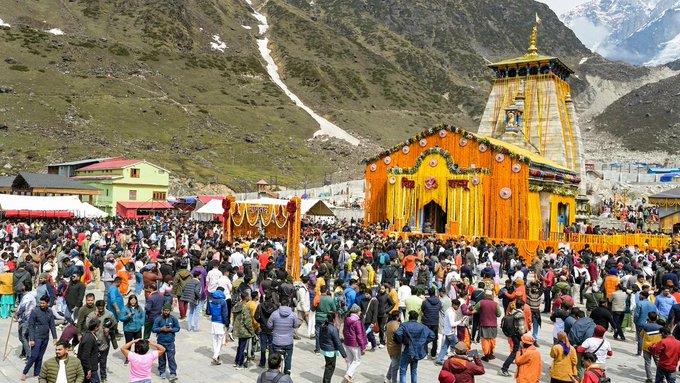Despite AAIB recommendations, flying conditions in Kedarnath valley see little improvement

Jun 17, 2025
DEHRADUN: The recent helicopter crash near Kedarnath, in which seven lives were lost, has proved yet again that aviation regulatory authorities have not learnt lessons from similar air mishaps in the challenging Kedar valley and have done little to improve flying conditions.
An Aryan Aviation Pvt Ltd.'s Bell 407 chopper with seven on board crashed and caught fire on June 15 while returning from Kedarnath over the forests of Gaurikund, killing all passengers, including pilgrims, the pilot and a 23-month-old toddler.
It was the fifth air accident involving a helicopter on the route within one and a half months since the start of the Char Dham yatra on April 30 this year.
A similar accident involving a helicopter of the same aviation firm took place near the Himalayan temple on October 18, 2022, killing as many people.
The Aircraft Accident Investigation Bureau (AAIB), which comes under the Ministry of Civil Aviation, probed the incident and gave its recommendations to the Uttarakhand Civil Aviation Development Authority (UCADA) in 2023 to avoid a repeat of the mishap.
Two years since the submission of the report, little has been done to implement its recommendations to rein in air accidents in the treacherous Char Dham sector, where pilots face several weather and terrain-related challenges.
In the October 2022 crash, which bore striking circumstantial resemblance to the June 15 crash, the helicopter impacted the ridge about 1.2 km from the helipad and toppled down the slope, breaking into pieces.
All seven on board the chopper, which was also a Bell 407, returning from Kedarnath to Guptkashi, were killed in the crash.
The AAIB, in its investigation report submitted to the UCADA after a gap of around a year in November 2023, said the accident was caused by an error of judgment on the part of the crew to correctly assess the deteriorating weather situation for a safe take-off and flight.
Fast descending clouds closed the departure path that may have been available to the preceding helicopter, and VT-RPN (the chopper that crashed) impacted the ridge due to obscured visibility, the AAIB said in its report.
The safety recommendations made by the bureau included setting up an Aviation Met Station manned by qualified Met experts at Kedarnath to provide more accurate weather updates to all operators flying into Kedarnath.
UCADA may approach the India Meteorological Department for providing such services at Kedarnath, it suggested.
According to the Standard Operating Procedure for chopper operations in Kedar valley, the crew are required to keep continuous watch on the weather in the valley, and in case of any doubt, it is advisable to return and wait at the helipad, it said.
The pilot first encountering bad weather is to give a call on Radio Telephony regarding the decision to call off due to bad weather, and this shall be acknowledged on RT and binding on all helicopters airborne at the time.
The operators/crew are required to obtain weather updates through the IMD from Dehradun before commencement of flight; however, there is a considerable difference in weather in the valley from that of Dehradun.
The SOP also contains various other procedures that require pilots to continuously have a weather watch and to ensure that, before the flight, actual weather conditions of the region and the helipads shall be ascertained and assessed.
Most of these procedures can be adopted only when actual weather conditions and trends are known to the crew before they decide to conduct the flight or not, the AAIB said.
However, in the absence of any Met facility in the valley, everything is dependent on the individual pilot's perception, it said.
With frequent changes in weather conditions in the valley, total dependency on pilots' perception cannot be relied upon every time, the AAIB's report said.
It recommended that the UCADA establish an Air Traffic Control (ATC) at Kedarnath for better control and monitoring of operations by helicopter operators, the bureau said in its report.
The operations in the valley are, however, in an uncontrolled environment as there is no ATC.
All operators file a Flight Plan at Delhi ACC and obtain FIC/ADC before taking off from their helipads.
The DGCA should ensure that helipads at shrines like Kedarnath, which handle a high number of sorties and passenger loads daily, should be licensed, and a helipad operator is individually responsible for the safety and security of helipad operations.
The DGCA should ensure that the operational areas at Kedarnath helipad have adequate CCTV coverage, and the availability of recordings should be checked during all audits and surveillances.
However, the Kedarnath helipad still does not have an ATC as recommended by the AAIB after its investigations into the October 18, 2022, crash.
When contacted, UCADA officials said the feasibility of setting up an ATC in Kedarnath is being explored.
Another major recommendation made by the AAIB for setting up an Aviation Met Station in Kedarnath has also not been implemented yet.
"There are more than a dozen cameras for weather monitoring, and the pilot has an app for weather updates. We have a mini weather station in the area apart from the real-time update system," UCADA CEO Sonika told reporters.